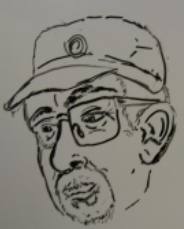YESTERDAY / TODAY
Today, the people of Grace Church stand firmly on the shoulders of giants. We are in the position to worship God, change lives, and serve our community in powerful ways because of the focus and determination of the generations of people who have poured into our church. Though we now have over 1,000 members, dozens of ministries, and a global impact, we still follow the example set by a small community nearly 200 years ago. Their values of accepting change, following the guidance of the Holy Spirit, and stepping out in faith will remain our guiding principles now and forever.
THE INDIANA CIRCUIT
In 1831, at the home of John Lucas about three miles west of the borough of Indiana, a class of Methodists was formed under the superintendence of the Reverend J. G. Sansom and continued to meet at the Lucas home for several years. They were under the official jurisdiction of the Conemaugh and Cambria Methodist Episcopal Mission. The first appointment of Indiana on a conference scroll came in 1834. Also in 1834 the Indiana Methodist Episcopal Church became the head of a large circuit. The Methodists of Indiana continued to meet in the old court house and occasionally in private homes.
A NEW DAY
By 1838, several additional Methodist families located in the area and it was deemed advisable to build a church. A meeting was called under the direction of the Reverend John Coil, then pastor of the circuit in which Indiana was a member. As a result a building committee was appointed naming Robert Craig, Edward Nixon, John Lucas, and William Fenton as members. A lot was purchased from the executors of the Thomas Sutton Estate for the sum of $50.00. The first ‘home’ of Methodism in Indiana was located on the corner of Water Street and Carpenter Avenue. It was a one-story brick church completed in 1841, and could accommodate 250 persons. The first sermon was preached by Reverend D. B. Campbell. This church served the congregation for thirty-five years. The growth of the new church was rapid, the membership and activities soon crowded the small quarters.
By 1874, plans were again formulated for the building of another church for Indiana Methodists. A lot on the corner of Church and South Seventh Streets was purchased for $1,950.00 and is part of the ground on which our present church now stands. Construction was begun and the cornerstone was laid October 5, 1875. A year later the building was completed and dedicated November 1, 1876. Total cost of the church was $20,000.00, and the debt was retired within the next two years.
THE TURN OF THE CENTURY
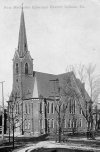 Shortly after the turn of the century, the Methodist membership began to feel the need of larger facilities. Mrs. J. N. Langham first proposed a new building and spearheaded a financial drive. The Golden Rule Class, later to become the Langham Class, raised in excess of $10,000 by selling subscriptions for magazines and other fund projects. This money was transferred to the Building Fund.
Shortly after the turn of the century, the Methodist membership began to feel the need of larger facilities. Mrs. J. N. Langham first proposed a new building and spearheaded a financial drive. The Golden Rule Class, later to become the Langham Class, raised in excess of $10,000 by selling subscriptions for magazines and other fund projects. This money was transferred to the Building Fund.
The entry of the United States in World War I postponed the plans for the new building, but the need and the drive were still there. In the interim period the Church acquired additional property on the corner of Seventh and Church Streets and by 1930 a new building was to be started.
The period between 1919 and 1929 brought to light many of the difficulties which led to the consideration of a new building. The membership had outgrown the old church and this was particularly true of the Sunday School department. The Sanctuary, which seated about 500 persons, was located on the second floor of the old building and was inaccessible to many of the members. Dampness caused continual scaling of the paint on all the walls, particularly the Sanctuary. Because of overcrowding several classes were forced to meet in an old brick house located next door to the church. Meeting in the house was not too inconvenient, however it was heated by individual small open gas stoves, one in each room, a definite hazard to everyone. The poorly equipped church kitchen was located in the cellar of the church with steep steps leading down to it.
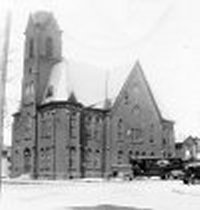 This posed many problems to the women who were cooking and serving meals. It was assessed that the old church building, now 55 years old, was run down, badly in need of costly repair and renovation.
This posed many problems to the women who were cooking and serving meals. It was assessed that the old church building, now 55 years old, was run down, badly in need of costly repair and renovation.
The membership wanted a new church. They wanted a new church with the Sanctuary on the first floor; they wanted a new Education Building large enough to accommodate the Sunday School classes and all the activities which had grown with the church. There was a great need for a Social Activity Hall, and a new dining hall with a modern, well equipped kitchen.
In 1930, the membership decided to build a new building. In the construction of the new church the Trustees had the responsibility, authority, and control of the physical property of the church as the amended charter states. They worked through a special building committee who did the supervision of the work. The following members composed the building committee: D. W. Simpson, chairman, James I. Henderson, John M. Miller, Frank H. Beck, Honorable J. Elder Peelor, Dr. Clark W. Rink, and Clarence C. Watson, secretary.
A fund-raising campaign was launched to raise or pledge money toward the building of the new church. As you know, this was not an easy job in that it was during the middle of the worst depression this country has ever known. During the financial drive $150,000.00 was raised in pledges.
DEMOLITIONS AND ORGANS
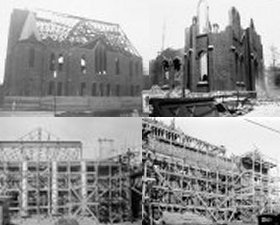 By the spring of 1930, the demolition of the old church was begun. After the razing $1600.00 was realized from the sale of salvaged materials. The old organ was sold to the local music house for $150.00. The pews were saved and installed in the present Peelor Chapel. By July ground had been broken for the new structure and it was under roof before cold weather that winter. From the time of the demolition of the old church until the completion of the new church the membership held services and meetings in the former Y.M.C.A. / Community Center Building on Philadelphia Street – now the home of the Indiana Free Library and Jimmy Stewart Museum. The cornerstone was laid December 7, 1930 and the new church was dedicated July 17, 1931. The new Pipe Organ was dedicated on the same day.
By the spring of 1930, the demolition of the old church was begun. After the razing $1600.00 was realized from the sale of salvaged materials. The old organ was sold to the local music house for $150.00. The pews were saved and installed in the present Peelor Chapel. By July ground had been broken for the new structure and it was under roof before cold weather that winter. From the time of the demolition of the old church until the completion of the new church the membership held services and meetings in the former Y.M.C.A. / Community Center Building on Philadelphia Street – now the home of the Indiana Free Library and Jimmy Stewart Museum. The cornerstone was laid December 7, 1930 and the new church was dedicated July 17, 1931. The new Pipe Organ was dedicated on the same day.
The building committee looked long and hard before they decided on the present form of architecture. In the construction of a new church many problems confronted the membership: the size of the building to meet the growing needs; keeping the building costs at a minimum without sacrificing the details which would do justice to the Methodist congregation and service. It was finally decided to build a New England Colonial type church with appointments to be in keeping with this particular style: brick exterior and the Sanctuary in the form and finish as you see it today.
A NEW VISION
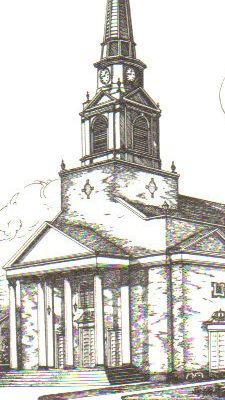 John T. Simpson, the architect selected, used the preliminary plans of the committee with suggestions relative to the number and size of rooms and in doing so he designed a beautiful colonial church in authentic design. His treatment of the wood exterior trim and the interior use of wood more than fulfilled the expectations of the committee and the church membership. The walls of the building are faced with rich red Colonial brick, the pillars are of white cast marble. The outside steps and platform and floor of the Narthex were of blue stone. The outside steps and platform have since been replaced with granite. Lighting fixtures are of Colonial design with pewter finish and are planned for convenience and economy of operation. The finished hardware is all of Colonial design. Many memorial gifts were made and enabled the committee to select the best appointments such as the pulpit, pews, the baptismal font, the tower clock, and many furnishings of the educational building. There is a fine clock in the church spire, which is crowned by a large cross – a modern church symbol of the Christian’s reach toward Heaven. The Sanctuary windows are glazed with twelve tint Colonial glass. An example of the famous Palladian three-part window typical of Early American Churches and popular with builders because of its graceful proportions is seen in the transept gallery walls. The three mahogany chippendale chairs on the chancel are replicas of the one used by George Washington at the signing of the Declaration of Independence. Total cost of the church was $260,000.00 and at the dedication the debt was $162,000.00. The debt was retired in 1949.
John T. Simpson, the architect selected, used the preliminary plans of the committee with suggestions relative to the number and size of rooms and in doing so he designed a beautiful colonial church in authentic design. His treatment of the wood exterior trim and the interior use of wood more than fulfilled the expectations of the committee and the church membership. The walls of the building are faced with rich red Colonial brick, the pillars are of white cast marble. The outside steps and platform and floor of the Narthex were of blue stone. The outside steps and platform have since been replaced with granite. Lighting fixtures are of Colonial design with pewter finish and are planned for convenience and economy of operation. The finished hardware is all of Colonial design. Many memorial gifts were made and enabled the committee to select the best appointments such as the pulpit, pews, the baptismal font, the tower clock, and many furnishings of the educational building. There is a fine clock in the church spire, which is crowned by a large cross – a modern church symbol of the Christian’s reach toward Heaven. The Sanctuary windows are glazed with twelve tint Colonial glass. An example of the famous Palladian three-part window typical of Early American Churches and popular with builders because of its graceful proportions is seen in the transept gallery walls. The three mahogany chippendale chairs on the chancel are replicas of the one used by George Washington at the signing of the Declaration of Independence. Total cost of the church was $260,000.00 and at the dedication the debt was $162,000.00. The debt was retired in 1949.
The building committee looked long and hard before they decided on the present form of architecture. In the construction of a new church many problems confronted the membership: the size of the building to meet the growing needs; keeping the building costs at a minimum without sacrificing the details which would do justice to the Methodist congregation and service. It was finally decided to build a New England Colonial type church with appointments to be in keeping with this particular style: brick exterior and the Sanctuary in the form and finish as you see it today. In 1955 the final parcel of land was purchased at a cost of $35,000.00 which was paid for in pledges. This completed the land acquisition plan started many, many years ago.
A DEVASTATING FIRE
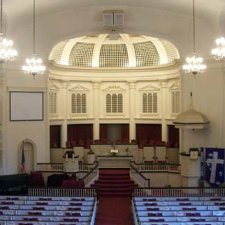 On August 7, 1974 a devastating fire damaged the roof, education wing and kitchen, suffering smoke and water damage. Throughout the church the smoke penetrated, which resulted in damage to carpets, draperies, walls and ceilings. A giant rebuilding and cleanup took place to restore the church to its former beauty. The kitchen was remodeled, the classrooms, Fellowship Hall, and upstairs offices were repaired, cleaned, and painted. The Sanctuary, Peelor Chapel, downstairs classrooms and offices were also cleaned and painted. The roof was reconstructed with extensive repair to the third floor. New carpet was put into rooms and offices as well as new draperies. In addition to this a new fire alarm system has been installed throughout the Church building. Additions to the church since that time include a fine new audio system in the Sanctuary.
On August 7, 1974 a devastating fire damaged the roof, education wing and kitchen, suffering smoke and water damage. Throughout the church the smoke penetrated, which resulted in damage to carpets, draperies, walls and ceilings. A giant rebuilding and cleanup took place to restore the church to its former beauty. The kitchen was remodeled, the classrooms, Fellowship Hall, and upstairs offices were repaired, cleaned, and painted. The Sanctuary, Peelor Chapel, downstairs classrooms and offices were also cleaned and painted. The roof was reconstructed with extensive repair to the third floor. New carpet was put into rooms and offices as well as new draperies. In addition to this a new fire alarm system has been installed throughout the Church building. Additions to the church since that time include a fine new audio system in the Sanctuary.
This was made possible through the generosity of Mrs. Grace Miller. Far-sighted planning by the Board of Trustees under the leadership of Robert DeGaetano made possible the installation of an efficient new heating system throughout the entire church building. In December 1979 the Memorial Committee and the church membership installed a carillon system in the bell tower of the church. The community now enjoys not only hearing the musical time bells but also brief bell recitals at noon and evening each day, with special programs during the holiday season.
THE DREAM LIVES ON
The final result, which so splendidly epitomizes Colonial beauty and simplicity was, and is, our own Grace Church. In addition to the continuing maintenance and improvement of the church structure itself, church programs continue to improve and increase. See other parts of this web site for the details of current church activities.


